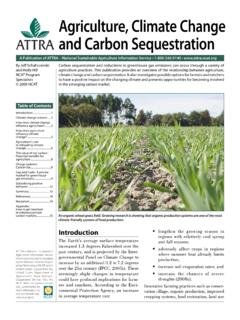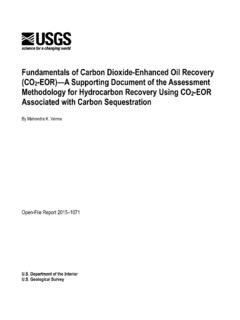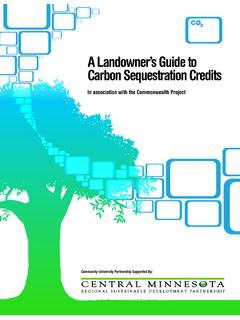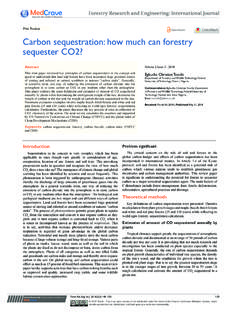Transcription of The Terrestrial Carbon Sink - Harvard University
1 EG43CH09_Keenan ARI 4 October 2018 13:33 Annual Review of Environment and ResourcesThe Terrestrial Carbon Keenan1,2and Williams31 Earth Sciences Division, Lawrence Berkeley National Laboratory, Berkeley, California 94720,USA2 Department of Environmental Science, Policy and Management, University of California,Berkeley, Berkeley, California 94720, USA; email: School of Geography, Clark University , Worcester, Massachusetts 01610, USA;email: Rev. Environ. Resour. 2018. 43:219 43 First published as a Review in Advance onSeptember 26, 2018 TheAnnual Review of Environment and Resourcesisonline at 2018 by Annual rights reservedKeywordsbiogeochemical, Carbon , cycle, ecosystem, land surface, model, nutrients,plant, Terrestrial biosphere, vegetation, waterAbstractLife on Earth comes in many forms, but all life-forms share a commonelement in Carbon .
2 It is the basic building block of biology, and by trap-ping radiation it also plays an important role in maintaining the Earth satmosphere at a temperature hospitable to life. Like all matter, Carbon canneither be created nor destroyed, but instead is continuously exchanged be-tween ecosystems and the environment through a complex combination ofphysics and biology. In recent decades, these exchanges have led to an in-creased accumulation of Carbon on the land surface: the Terrestrial carbonsink. Over the past 10 years (2007 2016) the sink has removed an Pg C year 1from the atmosphere, which amounts to of totalanthropogenic emissions from industrial activity and land-use change. Thissink constitutes a valuable ecosystem service, which has significantly slowedthe rate of climate change.
3 Here, we review current understanding of the un-derlying biological processes that govern the Terrestrial Carbon sink and theirdependence on climate, atmospheric composition, and human Rev. Environ. Resour. :219-243. Downloaded from Access provided by Harvard University on 12/20/18. For personal use only. EG43CH09_Keenan ARI 4 October 2018 13:33 Contents1. INTRODUCTION TO THE Terrestrial Carbon CYCLE.. 2255. THE Terrestrial Carbon 2286. SINK DYNAMICS ACROSS BIOCLIMATIC 2317. IMPLICATIONS FOR THE PRESENT AND THE 2341. INTRODUCTION TO THE Terrestrial Carbon CYCLEEach year, plants remove approximately one-fifth of the Carbon present in the atmosphere, a vastamount considering the miniscule scale of plants compared to the volume of air above them (1).
4 Carbon enters the leaves in gaseous form as Carbon dioxide (CO2), where it is converted throughphotosynthesis into sugars and starches (2). The total flux of Carbon removed is more than tentimes greater than what is emitted into the atmosphere through burning fossil fuels (3) and is thesource of sustenance for the majority of life on with many things in the natural world, this process of Carbon uptake is balanced by a coun-teracting force (4). Respiration, the mechanism by which plants, animals, and microbes convertsugars into energy, breaks the complex carbohydrate bonds formed through photosynthesis andreleases CO2back into the atmosphere. Combined with other processes, such as recurrent firesand dissolved organic Carbon transfer to aquatic systems (Figure 1), these flows of Carbon out ofecosystems largely offset the flows in Reference exchange of Carbon absorbed by photosynthesis, and released through respiration, waxesand wanes from day to night, through the seasons, and has natural cycles from decades to the past century, this breathing of the biosphere has resulted in a large and persistentnet removal of Carbon from the atmosphere by global Terrestrial ecosystems (5, 6).
5 Termed theterrestrial Carbon sink, this has served to slow the rate of accumulation of CO2in the atmosphere(7, 8), and thus the rate of climate change (9).It is critical to understand the reasons for the current sink, and that requires an in-depth under-standing of the spatial and temporal changes in the varied responsible processes. Our understand-ing of the underlying processes and their dependence on the key drivers of climate, atmosphericcomposition, and human land management has developed rapidly over the past decade, as havethe questions we are capable of answering. Here, we review recent developments and the currentstate of knowledge on the Terrestrial Carbon sink. We start by giving an overview of the terminol-ogy used to refer to different aspects of the Terrestrial Carbon cycle and present the fundamentalprinciples that characterize Carbon cycling in Terrestrial ecosystems.
6 We then examine recent de-velopments in our knowledge of how Carbon cycles through different ecosystems, and the toolsused. Finally, we conclude with discussion of the policy implications of a Terrestrial Carbon TERMINOLOGYThe Terrestrial Carbon cycle is the manifestation of multiple different processes operating onvaried temporal and spatial scales (Figure 1). The diversity of processes is matched by a wealth ofterminology (10) (Table 1). Here we discuss the key terms and their relationship to one Keenan WilliamsAnnu. Rev. Environ. Resour. :219-243. Downloaded from Access provided by Harvard University on 12/20/18. For personal use only. EG43CH09_Keenan ARI 4 October 2018 13:33 Natural Carbon transformationWeathering, erosion.
7 And transportHuman Carbon transformationCO2 released byvolcanic eruptionCO2 released byfossil fuelburning andcementproductionAnthropogenicextracti on of coaland oilCO2 uptake throughphotosynthesisCO2 release throughplant respirationSoil respirationSoil respirationSoil respirationWeathering/erosionRiver transport ofcarbon to open watersAgricultural waste burialAgricultural waste burialAgricultural waste burialAgricultural emissionsAgricultural emissionsAgricultural emissionsPlant mortality and senescencePlant mortality and senescencePlant mortality and senescenceCarbon transferredto the soil throughroot exudatesCarbon transferredto the soil throughroot exudatesCarbon transferredto the soil throughroot exudatesCO2 released bytransportCO2 released asvolatile organiccompoundsWildfire emissionsWildfire emissionsWildfire emissionsSoil organic matter accumulationSoil organic matter accumulationSoil organic matter accumulationFigure 1 The primary flows and exchanges that constitute the Terrestrial Carbon cycle, including uptake through photosynthesis, release to theatmosphere through both anthropogenic (fossil fuel emissions, biomass burning, land use) and natural emissions (autotrophic andheterotrophic respiration, wildfires, volcanic eruptions), and weathering, erosion, and transport.
8 Figure modified with permission fromDiana Swantek, Lawrence Berkeley National sequestration is the term used to describe the capture and long-term storage of CO2from the atmosphere. A forest, ocean, or other natural environment has the ability to sequestercarbon, through the movement of Carbon from short-lived labile pools such as leaves and hummus,tolong-livedpoolswithslowturnover timessuchasstandingbiomassorrecalcitrant organicmatterin soils. The ability to sequester Carbon is determined by the balance of time an ecosystem spendsbeing either a sink or a source of Carbon , which is defined based on an ecosystems ability to absorbCO2from the atmosphere. An ecosystem can be a sink for Carbon in one year, and a source inanother, but must be a sink over long timescales to sequester more ecosystems are often classified as sinks or sources based on observed fluxes of carbonbetween an ecosystem and the atmosphere, a true quantification of sink strength must take intoaccount all the pathways of Carbon transport, many of which are not represented in observations ofexchanges with the atmosphere.
9 Such quantification is termed the net ecosystem Carbon balance(NECB; 10) and accounts for all vectors of Carbon exchange between an ecosystem and its environ-ment. NECB is best conceptualized by considering an ecosystem as a volume (11), where the The Terrestrial Carbon Sink 221 Annu. Rev. Environ. Resour. :219-243. Downloaded from Access provided by Harvard University on 12/20/18. For personal use only. EG43CH09_Keenan ARI 4 October 2018 13:33 Table 1 Common terms and definitions associated with photosynthesis, respiration, and the natural Carbon cycleTermDefinitionPhotosynthesisThe mechanism by which plants synthesize complex carbohydrates from light and carbondioxide (CO2)Gross photosynthesisThe sum of Carbon fixed through carboxylation within the leaf chloroplasts (also referred to as truephotosynthesis)
10 Apparent photosynthesisCarbon assimilated though carboxylation minus photorespirationNet photosynthesisGross photosynthesis, minus photorespiration and dark respirationGross primary productivityEcosystem-scale apparent photosynthesisNet primary productivityEcosystem-scale apparent photosynthesis minus autotrophic respirationGross/net primary productionEcosystem-scale gross/net primary productivity when considered over longer time periodsRespirationThe mechanism by which plants, animals, and microbes convert sugars into energyAutotrophic respirationThe sum of respiration by all living plant material in an ecosystemPhotorespirationThe oxygenation of ribulose 1,5-bisphosphate (RuBP) by the enzyme RuBisCO in the chloroplastDark respirationThe release of CO2in the mitochondria, without the aid of lightMaintenance respirationMetabolism required to maintain an organism in a healthy, living stateGrowth respirationMetabolism associated with growth processes such as synthesis of new structures, nutrient uptake,N reduction, and phloem loadingHeterotrophic respirationThe respiration rate of all heterotrophic organisms (animals, fungi, and microbes)





